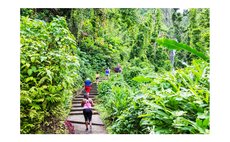Petite Savanne: A disaster unfolds
A Special feature on the past , present and future of Petite Savanne

Petite Savanne's early risers blink into wakefulness in murky pre-dawn light on August 27, 2015.
They're fully aware of what's going on above ground− Tropical Storm Erika's high-intensity rainfall is drenching the village sending floodwater surging to the Atlantic.
But they're not aware of what's happening underground. Deep beneath their feet, the land they love is straining and shifting under the pressure of the deluge.
Suddenly, huge swaths of land turn into volatile, heaving slurries. Tons of rocks, muddy water and debris hurtle down village slopes sucking up everything in their path.
In minutes, tens of villagers are missing. Scores of others are injured and hundreds have lost their homes, farms, livelihood and peace of mind.
Overnight, the village is transformed into a sodden wasteland. And the catastrophe is not yet over.
Early estimates of the economic losses—in terms of medical and cleanup costs, relocation costs, compensation, lost productivity—quickly mount to tens of millions of dollars.
The psychological costs spawned by the sudden loss of loved ones, friends, homes and livelihoods are incalculable.
Rescue and relief
It is evident that TS Erika impacted Petite Savanne more than any other community.
In the immediate aftermath, survivors are isolated with limited supplies of water, food and shelter.
Sanitary conditions deteriorate. Overland exit routes are cut off. Leaving by sea is fraught with uncertainties. Air access is limited to sporadic helicopter visits.
Most of all, there is little or no communication no radio, television, internet or mobile phone service. There's no clear idea of what they ought to do or what help is forthcoming and survivors are confused.
Thankfully, a relief team arrives with emergency medical supplies and some relief items. The first-responders are headed by Dominica's Minister of Health and Parliamentary Representative for the village, Dr. Kenneth Darroux, a medical doctor.
The team sets up a command post and activates rescue, relief and recovery operations. They do a phenomenal job with few resources, despite overwhelming challenges— no communication; no easy access.
Time passes and villagers remain stranded with little or no contact with the outside world.
As contact is slowly re-established, villagers are at the centre of an intense local and international storm-relief campaign. With overseas assistance, Government undertakes the evacuation of Petite Savanne and arranges safe accommodation for evacuees.
There is a huge outpouring of relief supplies, sympathy and goodwill for Petite Savanne survivors. Help pours in from Dominicans near and far; friends and supporters from all nations; the international donor community and disaster relief agencies.
This wellspring of aid covers most villagers' immediate human needs rescue, food, clothing, water, healthcare and temporary shelter. They also hear of plans for long-term aid— relocating them in safe areas and providing permanent housing.
All this will take time; nobody knows how long. Furthermore, the future of Petite Savanne is uncertain. Most of the land where the village once stood is unsafe; large areas may be permanently unsuitable for human habitation.
This reality is daunting. Villagers remain wary of the obvious challenges they will have to endure in their upheaval and resettlement. Despite their profound gratitude for all the help and support they're getting, troubling questions swirl in their minds.
Where will they eventually be resettled? Will the resettlement be fair and without fear or favour? Will they like living there? Can they earn a decent living there? What about lot sizes and land titles? Thankful, but uncertain; the villagers have more questions than answers.
Quest for answers
Petite Savanne survivors are not the only ones looking for answers to tough questions.
The enormity of this disaster has made it impossible to ignore flaws in Dominica's disaster preparedness and emergency response systems faults that cannot be ignored and need to be fixed.
A team of experts were studying the area up to press time. Many persons are looking forward to their findings in three particular areas, which can be summed up in three questions.
Tropical Storm Erika has prompted a number of questions as it relates to the island as a whole.
Why didn't meteorologists tracking TS Erika issue a tropical storm warning for Dominica? Why was Petite Savanne so severely affected? And, to what extent were the catastrophic events in the village avoidable?
In relation to the storm warning, the authorities are tight-lipped— at least, for now. Perhaps there are legal implications not yet in the public's view.
When all is said and done, Petite Savanne can take many positives from this tragedy, especially the courage, unity, resourcefulness indomitable spirit of the villagers in times of trouble plus the unreserved outpouring of help and support.
Hopefully, these ignite a new age in Dominica in which the lessons from disasters generate new, more effective disaster preparedness and emergency response systems.
Meantime, Petite Savanne remains on the edge. And the future of its residents hangs precariously in the balance.




